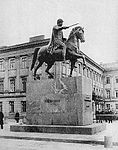Józef Poniatowski Monument (Warsaw)
The Józef Poniatowski Monument in Warsaw is the work of the Danish sculptor Bertel Thorvaldsen , who also created the Warsaw Monument to Nicolaus Copernicus .
The equestrian monument was created based on the model of the equestrian statue of Mark Aurel on the Roman Capitol Square . Prince Poniatowski was depicted in ancient garb with a short sword in his right hand.
The statue was ordered from the Danish sculptor in 1817. It wasn't until 1830 that a full-size plaster model was presented to the Warsaw public. There was criticism, because the Poles expected the representation of the national hero in armor. The bronze sculpture was made in 1832. In the meantime, however, the Russian authorities had withdrawn permission to erect the monument in Warsaw because of the November Uprising (1830–1831). The monument was confiscated and taken to the Modlin Fortress , where it was considered a statue of Saint George. The headquarters of the fortress gave the sculpture to the governor, Prince Ivan Fyodorovich Paskevich , in 1840 , who first brought it to the Dęblin fortress and then to Gomel . It wasn't until 1922 that the statue was returned to Poland thanks to the Riga Peace Treaty .
The memorial was first erected temporarily at the court of the Warsaw Royal Castle , and then finally in front of the Saxon Palace and the tomb of the unknown soldier .
After the Warsaw Uprising was put down, it was blown up on December 16, 1944 on the orders of Erich von dem Bach-Zelewski .
The sculpture was restored from the model in the Thorvaldsen Museum in Copenhagen in 1948–1951 and given to Poland as a gift from the Kingdom of Denmark . It was first installed in Łazienki Park in front of the Old Orangery and then in 1965 in its current location in front of the Warsaw Presidential Palace .
swell
- Hanna Kotkowska-Bareja: Pomnik Poniatowskiego. Wydawnictwo PWN, Warszawa 1971
Coordinates: 52 ° 14 ′ 34.1 ″ N , 21 ° 0 ′ 55.7 ″ E


